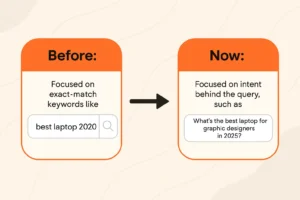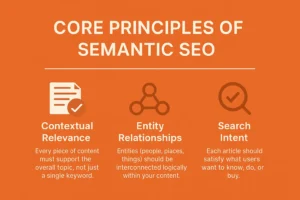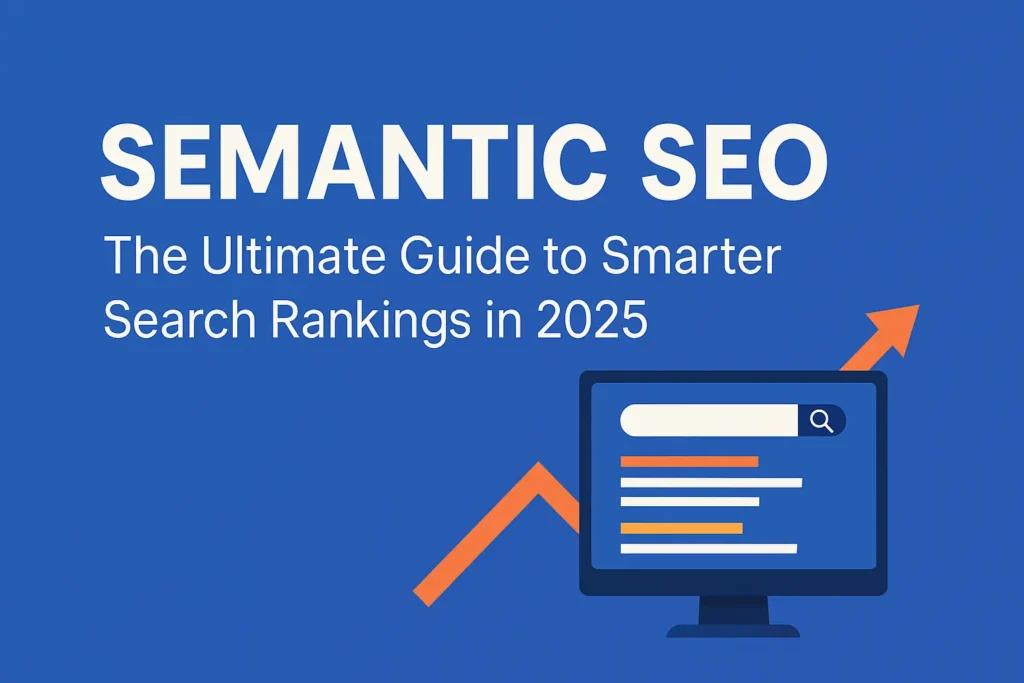Table of Contents
ToggleWhat Is Semantic SEO? Understanding the Concept
Semantic SEO is the practice of optimizing your content around meaning and intent rather than just keywords. Instead of focusing solely on specific phrases, Semantic SEO considers context, entity relationships, and user purpose. In simple terms, it’s about making your content understandable not only to humans but also to machines like Google’s algorithms.
When Google launched updates like Hummingbird, RankBrain, and BERT, the search engine began interpreting why a user searches for something instead of what exact words they use. This shift turned traditional SEO, where keyword stuffing once worked, into an outdated practice.
Semantic SEO now demands that websites deliver topical depth, structured context, and intent-aligned answers that meet the user’s needs directly.
For example, instead of writing a single article targeting “SEO,” Semantic SEO encourages you to build an entire topic cluster with related content like “keyword research,” “on-page optimization,” and “semantic search.” Each page supports the other, creating a context-rich web of information that Google understands deeply.
Evolution from Traditional SEO to Semantic SEO
The old SEO model prioritized keywords and backlinks, often neglecting content quality and relevance. However, modern search engines now use Natural Language Processing (NLP) and machine learning to analyze context and semantics.

Before: Focused on exact-match keywords like “best laptop 2020.”
Now: Focused on intent behind the query, such as “What’s the best laptop for graphic designers in 2025?”
This transformation allows search engines to connect semantically similar queries, even if they don’t share the same words.
Why Semantic SEO Matters in 2025
Semantic SEO has become essential for ranking in 2025 because of how Google’s algorithms and AI-driven search engines evaluate content.
Here’s why it’s critical:
Better Search Intent Matching: Users get more accurate, intent-aligned results.
Increased Visibility in Featured Snippets & Knowledge Panels.
Improved Contextual Authority: Search engines recognize your site as a credible source within a specific topic area.
Voice & Visual Search Optimization: Semantic SEO supports how AI tools like Google Assistant interpret complex questions.
The integration of AI and semantics is shaping a world where understanding meaning, not just words, defines your ranking potential.
Core Principles of Semantic SEO
Semantic SEO relies on three key principles:

Contextual Relevance: Every piece of content must support the overall topic, not just a single keyword.
Entity Relationships: Entities (people, places, and things) should be logically interconnected within your content.
Search Intent: Each article should satisfy what users want to know, do, or buy.
This approach helps Google understand how your pages fit into a larger knowledge framework.
How Semantic SEO Works: Behind the Scenes
Search engines like Google use Knowledge Graphs, NLP models, and schema markup to analyze content semantically.
Knowledge Graph: Connects entities like “Apple” (the company) and “iPhone” through meaning.
Schema Markup: Helps Google understand what your content is about using structured data.
Entity Recognition: Detects real-world concepts and their relationships.
These tools ensure that when someone searches for “best fruit for vitamin C,” Google can distinguish between “Apple” the fruit and “Apple” the brand.
Building a Semantic SEO Strategy for Your Website
Step 1: Identify Core Topics and Subtopics
Start by mapping your main topic (“pillar”) and related subtopics (“clusters”). For example, “Semantic SEO” can have clusters like “topic clusters,” “entity optimization,” and “schema markup.”
Step 2: Create Interlinked Content Clusters
Link related articles internally to strengthen contextual relevance. Each page supports another, signaling to Google that you’re an authority in that niche.
Step 3: Use Schema Markup
Apply JSON-LD schema to articles, products, and reviews so Google can understand your entities clearly.
Step 4: Optimize for Intent
Ensure each page answers a specific user question, like “how to implement semantic SEO,” to improve engagement and dwell time.
Semantic Keyword Research Techniques
Finding the right keywords for Semantic SEO is about understanding intent and relationships, not just search volume. Instead of stuffing keywords, you’re mapping the semantic network of topics your audience cares about.
Using NLP Tools for Semantic Keyword Discovery
Natural Language Processing (NLP) tools like Google Natural Language API, SurferSEO, and MarketMuse can identify entities, topics, and context in your niche.
These tools reveal semantic associations—words and phrases that naturally co-occur within authoritative content on your topic.
For example, if your focus keyword is “Semantic SEO,” related semantic terms could include:
“entity-based optimization”
“contextual search”
“natural language processing”
“topic clusters”
“knowledge graph”
Incorporating these naturally makes your content machine-readable and contextually rich.
Leveraging Google’s “People Also Ask” and Related Searches
These SERP features are goldmines for semantic keyword expansion.
By analyzing the People Also Ask section, you can find real user questions to structure your headings around, improving contextual flow and E-E-A-T (Experience, Expertise, Authority, and Trust).
Additionally, tools like AnswerThePublic and AlsoAsked visualize semantic relationships between queries—helping you build content clusters that mirror how users think.
On-Page Optimization for Semantic SEO
Writing Contextually Rich Content
Instead of repeating keywords, focus on semantic depth. Write content that answers related subtopics, connects ideas logically, and anticipates user intent.
For instance, if your topic is “Semantic SEO,” include contextual references like “how Google interprets meaning,” “AI-driven content understanding,” and “entity markup.”
Using Synonyms, Variations, and Related Entities Naturally
Search engines are intelligent enough to recognize synonyms and variations. For example:
“Search engine optimization” ≈ “SEO”
“AI-powered search” ≈ “intelligent ranking systems”
Using these variations helps maintain readability while signaling contextual understanding to Google.
Internal Linking and Semantic Context Flow
Internal links are essential for connecting semantically related pages.
A well-linked cluster tells Google that your content isn’t isolated—it’s part of a broader ecosystem of knowledge.
For example:
Link from “What Is Semantic SEO?” → “How to Build Topic Clusters”
Link from “Schema Markup Guide” → “Entity Optimization Strategies”
This approach builds semantic authority and enhances crawlability.
Off-Page Factors Influencing Semantic SEO
Semantic SEO doesn’t stop at on-page optimization. Off-page signals also play a vital role in building entity-based authority.
Link Relevance vs. Link Quantity
Gone are the days of acquiring hundreds of backlinks for the sake of volume.
Now, contextually relevant links from semantically related sources carry more weight.
A backlink from a “digital marketing” site to your Semantic SEO article is more valuable than one from an unrelated niche.
Entity Mentions and Brand Authority Building
Even unlinked mentions can strengthen your entity recognition in Google’s Knowledge Graph.
When your brand is repeatedly referenced in relevant contexts, Google associates it with certain topics—enhancing topical authority.
Participating in guest posts, podcasts, and expert roundups can boost your brand’s semantic footprint.
Measuring the Success of Semantic SEO
Metrics to Track
To determine whether your Semantic SEO efforts are effective, monitor:
Engagement Metrics: Time on page, dwell time, bounce rate.
Semantic Visibility: How often your site appears for semantically related queries.
Featured Snippets and Knowledge Panels: Indicators of contextual relevance.
Tools for Measuring Semantic SEO Performance
Tools like Google Search Console, Ahrefs, SEMrush, and InLinks help analyze how Google perceives your site semantically.
You can also use Frase.io or SurferSEO to evaluate content depth and topic coverage across your domain.
Common Mistakes to Avoid in Semantic SEO
Over-Optimizing for Entities:
Adding too many entities or overusing schema markup can make your content look artificial. Keep it natural and human-friendly.Ignoring Search Intent:
Writing semantically rich content without addressing intent is like building a mansion with no entrance. Always align each article with user goals.Failing to Update Content:
Semantic relationships evolve as new entities and topics emerge. Regularly refresh your content to maintain contextual relevance.
Future of Semantic SEO and AI Integration
Role of Generative AI in Content Understanding
AI systems like ChatGPT and Google’s Gemini are shaping how semantic search operates.
They analyze relationships, tone, and intent—not just words—making semantic context more important than ever.
As AI becomes more conversational, content that mimics natural language patterns and offers depth will outperform generic keyword-focused posts.
Semantic Search and the Evolution of Voice & Visual Search
Voice assistants like Alexa and Siri rely heavily on semantic understanding.
Optimizing for natural speech patterns (“How do I improve my SEO using AI?”) and visual queries (images with metadata and alt text) will be key to future-proofing your SEO strategy.
Conclusion: Unlock the Power of Semantic SEO with BeTopSEO
At BeTopSEO, we believe that Semantic SEO isn’t just the future, it’s the present of digital success. As Google and other search engines evolve to understand intent, context, and meaning, brands that adopt semantic strategies will rise above their competitors, who are still clinging to outdated keyword tactics.
Our expert SEO team in Hyderabad, India, specializes in crafting AI-driven, context-rich, and entity-based SEO strategies that align perfectly with modern search algorithms. We go beyond keyword optimization. We build semantic content ecosystems that strengthen your brand’s authority, improve user engagement, and secure long-term organic growth.
Whether you’re a startup looking to build online visibility or an enterprise aiming for top-tier rankings, BeTopSEO provides the right blend of technology, strategy, and expertise to help your business thrive in the semantic era.
Partner with the best SEO company in Hyderabad and let us transform your website into a contextually intelligent, search-optimized powerhouse that Google and your audience both love.
👉 Ready to dominate search rankings with Semantic SEO?
Contact BeTopSEO today and experience what smart SEO truly means.
📞 Visit: www.betopseo.com
📍 Serving clients across Hyderabad, India, and worldwide.
FAQs About Semantic SEO
Semantic SEO means optimizing for meaning and intent instead of just keywords. It focuses on how topics and entities connect contextually.
Traditional SEO targets specific keywords, while Semantic SEO targets topics and context, aiming to satisfy search intent comprehensively.
Tools like InLinks, MarketMuse, SurferSEO, and Frase.io assist with semantic analysis, entity recognition, and content optimization.
Yes! Schema markup helps Google understand the structure and meaning of your content, increasing your chances of appearing in rich results.
Absolutely. Voice assistants interpret conversational language, making semantic structure crucial for answering voice queries effectively.
It usually takes 3–6 months to see measurable improvements, depending on your niche, competition, and content depth.

